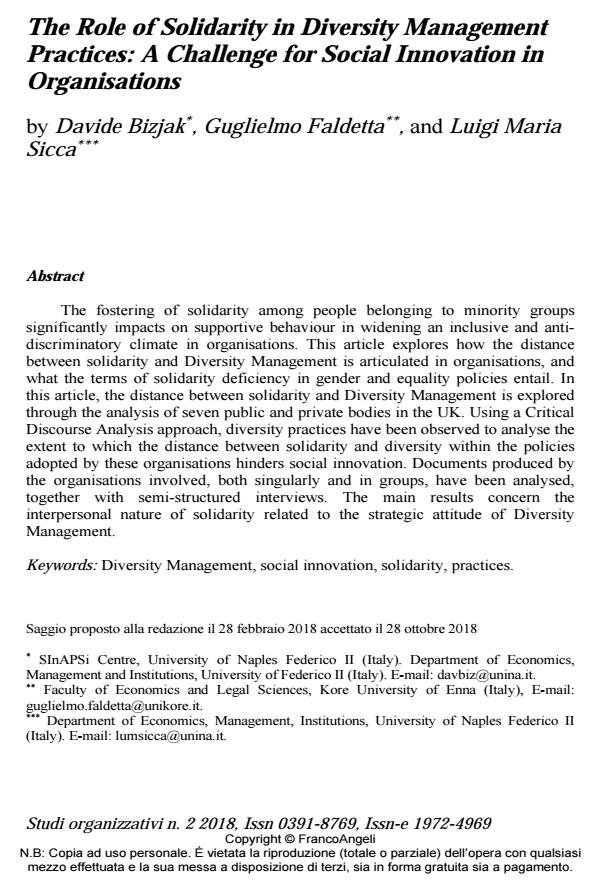The Role of Solidarity in Diversity Management Practices: A Challenge for Social Innovation in Organisations
Titolo Rivista STUDI ORGANIZZATIVI
Autori/Curatori Davide Bizjak, Guglielmo Faldetta, Luigi Maria Sicca
Anno di pubblicazione 2019 Fascicolo 2018/2
Lingua Inglese Numero pagine 17 P. 130-146 Dimensione file 237 KB
DOI 10.3280/SO2018-002006
Il DOI è il codice a barre della proprietà intellettuale: per saperne di più
clicca qui
Qui sotto puoi vedere in anteprima la prima pagina di questo articolo.
Se questo articolo ti interessa, lo puoi acquistare (e scaricare in formato pdf) seguendo le facili indicazioni per acquistare il download credit. Acquista Download Credits per scaricare questo Articolo in formato PDF

FrancoAngeli è membro della Publishers International Linking Association, Inc (PILA)associazione indipendente e non profit per facilitare (attraverso i servizi tecnologici implementati da CrossRef.org) l’accesso degli studiosi ai contenuti digitali nelle pubblicazioni professionali e scientifiche
The fostering of solidarity among people belonging to minority groups significantly impacts on supportive behaviour in widening an inclusive and anti-discriminatory climate in organisations. This article explores how the distance between solidarity and Diversity Management is articulated in organisations, and what the terms of solidarity deficiency in gender and equality policies entail. In this article, the distance between solidarity and Diversity Management is explored through the analysis of seven public and private bodies in the UK. Using a Critical Discourse Analysis approach, diversity practices have been observed to analyse the extent to which the distance between solidarity and diversity within the policies adopted by these organisations hinders social innovation. Documents produced by the organisations involved, both singularly and in groups, have been analysed, together with semi-structured interviews. The main results concern the interpersonal nature of solidarity related to the strategic attitude of Diversity Management.
Il concetto di solidarietà nell’àmbito dell’Organizzazione delle Risorse Umane e del Diversity Management risulta essere ancora poco indagato dagli studi organizzativi. Poiché si richiede di colmare un gap sia teorico che pratico, si persegue qui un duplice obiettivo: da una parte avvicinare il dibattito sul Diversity Management a quello sulla solidarietà; dall’altro, fornire una chiave di lettura sulle pratiche di Human Resource Management, al servizio dell’inclusione organizzativa e dell’innovazione sociale. Dal punto di vista teorico, questo articolo esplora la possibilità che gli studi sulla solidarietà nelle organizzazioni e quelli sul Diversity Management possano dialogare su un terreno comune; sulla base dell’ipotesi che la mancanza di attenzione alla solidarietà nelle pratiche di Diversity Management sia un fattore incentivante di esclusione per i membri dell’organizzazione a rischio discriminazione. Dal punto di vista pratico, si restituisce una descrizione dello stato dell’arte dell’inclusione nelle organizzazioni indagate, secondo un approccio di Critical Discourse Analysis (CDA) e analisi dei testi. Lo studio empirico riportato coinvolge sette organizzazioni del Regno Unito, tutte collocate nella stessa regione e appartenenti al medesimo comitato di promozione e scambio di buone pratiche per l’inclusione della comunità LGBTIQ+. Le sette organizzazioni indagate sono sia pubbliche (polizia, vigili del fuoco), sia private (una multinazionale dei servizi integrati e una charity), fornendo così un quadro complessivo ed omogeneo delle condizioni di inclusione/esclusione delle organizzazioni appartenenti al comitato oggetto di studio. Le fonti testuali, tra cui documenti e trascrizioni delle interviste, sono state trattate incrociando i dati di una word frequency count e di una cluster analysis. I principali risultati evidenziano due aspetti: la distanza concettuale, ipotizzata attraverso lo studio della letteratura, corrisponde a una distanza misurabile empiricamente attraverso la correlazione tra i cluster analizzati. Inoltre, l’esistenza di punti di contatto tra la letteratura sulla solidarietà e quella sul Diversity avvalora ulteriormente i risultati raggiunti sul piano empirico, auspicando una ulteriore integrazione, che attraversi il piano teorico per arrivare a coinvolgere il piano delle pratiche manageriali di Organizzazione e Gestione delle Risorse Umane.
Parole chiave:Gestione delle diversità; innovazione sociale; solidarietà, pratiche.
Davide Bizjak, Guglielmo Faldetta, Luigi Maria Sicca, The Role of Solidarity in Diversity Management Practices: A Challenge for Social Innovation in Organisations in "STUDI ORGANIZZATIVI " 2/2018, pp 130-146, DOI: 10.3280/SO2018-002006